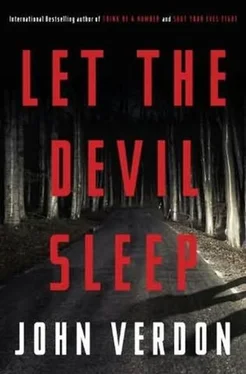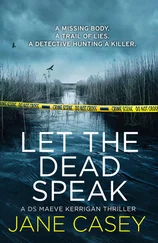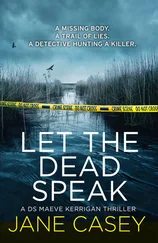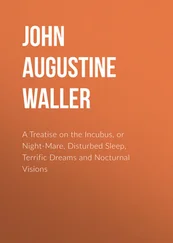A Simple Initiative
The bedroom ceiling seemed a little brighter now, the sheet covering Gurney a little warmer. He felt satisfied that his sequential reconstruction of the previous evening’s affair was reasonably complete and orderly. Its significance, causes, purposes, motivations were yet to be determined. But at least he was starting to feel that he was on a path.
He closed his eyes.
He was awakened minutes later by the phone, followed by footsteps. It was picked up at the end of the fourth ring. He heard Madeleine’s voice, indistinctly, coming from the den. A few sentences, silence, then footsteps again. He thought she might be bringing the phone to him. Someone asking for him. Huffbarger, the neurologist? He thought back on the testy exchange with the doctor’s office person. Christ, when was that? Two or three days ago? Seemed like forever.
The footsteps passed the bedroom door, went out to the kitchen.
Female voices.
Madeleine and Kim.
Kim had driven him to Walnut Crossing after taking him to the emergency room in Syracuse. He hadn’t been able to grip the gearshift in his Outback without a red-hot stabbing sensation in his elbow-giving him the idea that his arm might be fractured and that trying to shift with it might not be smart-and Kim had seemed more than happy for an excuse to spend the night someplace other than in her apartment.
He recalled how she’d emphasized that it wouldn’t be safe for him to drive himself-even after the X-rays had shown that there was no fracture.
There was something about Kim’s attitude, her way of presenting herself to the world, that made him smile. She could gladly leave her apartment on a mission of mercy, but never because she’d been driven away by fear.
He forced himself out of bed-discovering new muscle aches as he did so. He took four ibuprofens and got into a hot shower.
The shower and pills performed, to some degree, their restorative magic. By the time he was dried off and dressed and out by the kitchen coffeemaker, pouring his vital first cup, he was feeling a bit better. He flexed the fingers of his right hand, found that the pain was tolerable. He squeezed the coffee cup. Despite the wince it produced, he concluded that he could manage his gearshift if he needed to drive. It wouldn’t be comfortable, but he wasn’t helpless.
There was no sign of either Madeleine or Kim in the house. He could hear a low murmur of voices through an open window by the sideboard. He took his cup to the breakfast table by the French doors. Then he saw them, out beyond the bluestone patio, beyond the overgrown apple tree, in the small mowed area of the field that he and Madeleine referred to as “the lawn.”
They were sitting in a pair of matching Adirondack chairs. Madeleine was wearing one of her wildly colorful jackets, and Kim was wearing a similar one-no doubt provided by Madeleine. They were each cradling a coffee mug in a two-handed grip, as though warming their fingers around a pleasant flame. The lavenders and fuchsias and oranges and lime greens of their jackets were radiant in the pale morning sunlight beginning to filter through the overcast. Their expressions suggested that their conversation, like their clothing, was more animated than Gurney’s mood.
He was tempted to open the French doors to see if the sun was taking any of the chill out of the atmosphere. But he knew that as soon as Madeleine saw him, she’d tell him he should come out, tell him what a lovely morning it was turning out to be after all, tell him how sweet everything smelled. And the more she’d rhapsodize about the glory of being out in the open air, the more he’d insist on staying in. It was a ritual battle they often fought, virtually reading their lines from a script. In the end, after making it clear he was too busy to come out, he’d inevitably reconsider, and, once out, inevitably he’d be pleased by the beauty of the day and embarrassed by his childish opposition.
At the moment, however, he had no desire to initiate the ritual. So he chose not to open the door. Instead he decided to get a second cup of coffee, print out a hard copy of the Good Shepherd profile, and try to approach it with an open mind: a mind open to the possible presence of truth, rather than a mind hypervigilant for the presence of bullshit.
He went into the den and opened the Hardwick e-mails on his desktop computer, a welcome improvement over the tiny screen of his cell phone. While the profile was printing out, he opened the first of the incident-report documents that he’d hurried through the previous afternoon.
He wasn’t sure what he was looking for. He was still at the stage when the important thing was to look at everything, absorb as much data as he could. The decisions about what was significant, the search for patterns-that would come later.
He realized he’d been in too much of a rush the first time. He needed to slow down. He’d discovered over the years that one of the most destructive errors a detective can make is to leap to a possible pattern with too little data. Because once you think you see a pattern, there’s an inclination to dismiss data that doesn’t fit into it. The brain’s natural affinity for pattern formation devalues dots that don’t contribute to the picture. Add to that a detective’s professional need to grasp the outline of a situation quickly, and the result is a tendency to jump to premature conclusions.
The period of simple looking, listening, absorbing had tremendous value. Giving that period its full due was always the best way to begin an investigation.
Begin an investigation?
Begin an investigation of what, exactly? At whose request? With what legal authorization? In potential collision with Schiff and who else?
He decided to simplify the matter-or at least detoxify the terminology-by thinking of it as nothing more than a private fact-finding initiative, a modest effort to answer a few questions. Questions such as:
Who was behind the original “pranks” that had disturbed Kim?
Which was closer to the truth-Kim’s characterization of Meese or his characterization of her?
Who set the vicious little trap that had thrown him to the basement floor? Was he the intended victim or was Kim?
If the whisper had been real, who was the whisperer? Why was he lurking in the basement? How and when had he gotten into the house, and how had he gotten away?
What was the meaning of the warning “Let the devil sleep”?
And what, if anything, did these present events have to do with a ten-year-old series of roadway murders?
Gurney envisioned his fact-finding initiative beginning with a review of everything in the incident reports, the report annexes, the ViCAP reports, the FBI profile, the status reports in Kim’s project folder, and the notes he’d taken while listening to Hardwick’s acerbic summaries of the victims’ personalities.
All of that he could address by himself. But he also felt a growing urge to sit down with Rebecca Holdenfield and delve more deeply into the Good Shepherd profile and the case hypothesis-how the primary data was gathered, analyzed, prioritized; how theoretical alternatives had been tested; how consensus had emerged; and whether any beliefs she had about the case had changed over the years. He was also curious to know whether she’d ever spoken to Max Clinter.
Gurney still had Holdenfield’s number in his cell phone. (They’d collaborated briefly on the Mark Mellery and Jillian Perry cases, and he’d imagined they might cross paths again.) He brought the number up on the screen and placed the call. It went into her voice mail.
He listened to a lengthy introductory message regarding her office hours and location, website, and the e-mail address to which inquiries could be sent. The sound of her voice conjured up an image of the woman. Tough, brainy, athletic, and ambitious. Her facial features were perfect without being pretty. Her eyes were striking, intense, but lacked the warmth that might have made them beautiful. She was a driven professional whose therapy practice filled whatever time was left over from her primary career in forensic psychology.
Читать дальше












